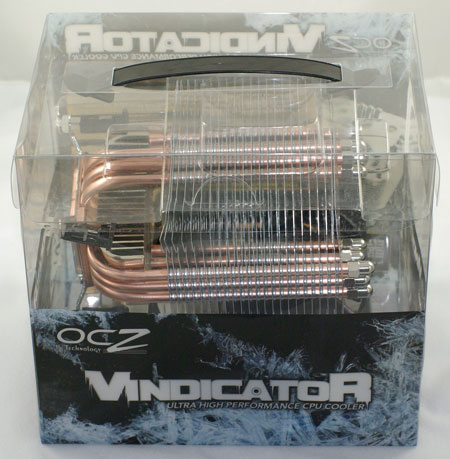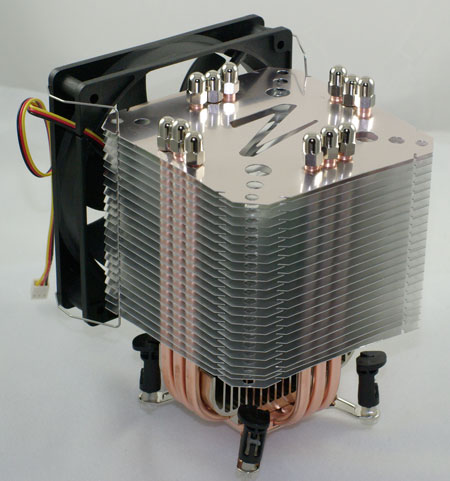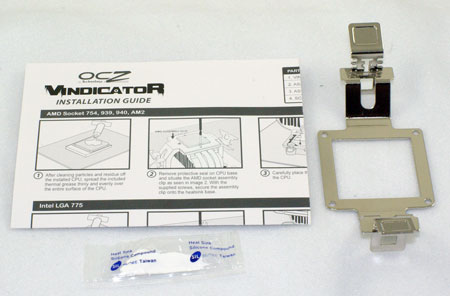OCZ Vindicator: Heatpipe Tower Cooling from OCZ
by Wesley Fink on April 5, 2007 4:00 AM EST- Posted in
- Cases/Cooling/PSUs
OCZ Vindicator
The Vindicator is packaged is a slick acrylic box. This certainly allows the package to stand out on shelves, since you can see everything about the cooler through the clear shell.

While the packaging makes the Vindicator stand out, we do have some questions about how well it protects the heatpipe tower from damage during shipment. The cooler we received looked great in the package and the package seemed sturdy enough, but the shipping process had caused a lot of crushed fins opposite the visible side of the package. They were straightened with a knife and some patience, but not all buyers will want to straighten fins on a new cooler. A sturdier package would help.

The Vindicator cooler is a bit different in configuration from most other heatpipe coolers. While it uses 6 u-shaped heatpipes to cool they are arranged as 3-pipe arrays at a ninety degree angle. This places three heatpipe rods on each side. Unlike the Scythe Infinity or Thermalright Ultra 120, which are wider than they are flat, the Vindicator design makes a square cooler which is much deeper than most of the other heatpipe coolers. This is the same configuration used in the Scythe Ninja Rev. B.

As already mentioned the Socket 775 adapter is installed, but the AM2/939/940/754 adapter is also included along with a small packet of thermal compound and installation instructions. You are not required to remove the motherboard to mount the Vindicator. It uses standard Intel-type push pins for mounting on Socket 775. However, space is very limited above the mounting area so you will likely want to mount the Vindicator before installing a fan.
The Vindicator is a big cooler and it takes up a lot of space in the case. While a simple installation is always preferred, the weight that is being supported by those four pop-in clips is a real concern. With no back plate this is not a cooler you will want to use in a system you move around. The motherboard could easily be overstressed and fail or it could actually break the board with rough handling.
Specifications
The Vindicator will mount on all current CPU sockets, but it does not support the older Intel Socket 478. If you have a Socket 478 CPU you will need to buy the Scythe Ninja Rev. B instead.
The fan included with the Vindicator is clearly aimed at the silent cooler market. The airflow is relatively low and noise is rated at just 18.5 DBA. However, the fan mount will handle any 120mm fan, so you can choose from a wide variety of popular 120mm fans if the stock fan does not deliver what you are looking for.
The Vindicator also allows mounting of multiple fans if you choose, as we demonstrated in the Scythe Infinity review. The aluminum cooling fins have a pair of grooves on each side to provide flexibility in fan mounting. Using extra wires and careful positioning you should be able to mount as many as 4 fans for cooling on the Vindicator.
The Vindicator is packaged is a slick acrylic box. This certainly allows the package to stand out on shelves, since you can see everything about the cooler through the clear shell.

While the packaging makes the Vindicator stand out, we do have some questions about how well it protects the heatpipe tower from damage during shipment. The cooler we received looked great in the package and the package seemed sturdy enough, but the shipping process had caused a lot of crushed fins opposite the visible side of the package. They were straightened with a knife and some patience, but not all buyers will want to straighten fins on a new cooler. A sturdier package would help.

The Vindicator cooler is a bit different in configuration from most other heatpipe coolers. While it uses 6 u-shaped heatpipes to cool they are arranged as 3-pipe arrays at a ninety degree angle. This places three heatpipe rods on each side. Unlike the Scythe Infinity or Thermalright Ultra 120, which are wider than they are flat, the Vindicator design makes a square cooler which is much deeper than most of the other heatpipe coolers. This is the same configuration used in the Scythe Ninja Rev. B.

As already mentioned the Socket 775 adapter is installed, but the AM2/939/940/754 adapter is also included along with a small packet of thermal compound and installation instructions. You are not required to remove the motherboard to mount the Vindicator. It uses standard Intel-type push pins for mounting on Socket 775. However, space is very limited above the mounting area so you will likely want to mount the Vindicator before installing a fan.
The Vindicator is a big cooler and it takes up a lot of space in the case. While a simple installation is always preferred, the weight that is being supported by those four pop-in clips is a real concern. With no back plate this is not a cooler you will want to use in a system you move around. The motherboard could easily be overstressed and fail or it could actually break the board with rough handling.
Specifications
The Vindicator will mount on all current CPU sockets, but it does not support the older Intel Socket 478. If you have a Socket 478 CPU you will need to buy the Scythe Ninja Rev. B instead.
| OCZ Vindicator Specifications | |
| Heatsink | |
| Dimensions | 110(L) X 110(W) X 150(H)mm (excluding fan) |
| Weight | 640g (excluding fan) |
| Material | Copper and Aluminum |
| Fan Configuration | Supports 120mm fans (120mm fan included) Open or closed mounting posts. |
| Included Fan | |
| Fan Size | 120mm x 120mm x 25mm |
| Bearing Type | Sleeve Bearing |
| Noise Level | 18.5 dB-A |
| Speed | 1000 RPM |
| Air Flow | 40 CFM |
| Static Pressure | 1.40mm H2O |
| Weight | 130g (fan only) |
The fan included with the Vindicator is clearly aimed at the silent cooler market. The airflow is relatively low and noise is rated at just 18.5 DBA. However, the fan mount will handle any 120mm fan, so you can choose from a wide variety of popular 120mm fans if the stock fan does not deliver what you are looking for.
The Vindicator also allows mounting of multiple fans if you choose, as we demonstrated in the Scythe Infinity review. The aluminum cooling fins have a pair of grooves on each side to provide flexibility in fan mounting. Using extra wires and careful positioning you should be able to mount as many as 4 fans for cooling on the Vindicator.










41 Comments
View All Comments
Wesley Fink - Thursday, April 5, 2007 - link
You make a good point, but I remain concerned about introducing additional noise and cooling variables into the test platform with a variable fan speed PS. In flat out gaming every PS I have seen is running at load conditions. However, your suggestions are certainly "real world" and we will definitley evaluate the impact of one of the "silent idle" power supplies on our total cooler testing. Our goal is to find ways to lower the ambient noise and sytem noise floor in realistic ways to provide a wider db test rangeyacoub - Thursday, April 5, 2007 - link
Yeah exactly. My PC DOESN'T sit at Load settings for its fans. See I actually have them all dynamically controlled by temp and they only spin up when the machine is actually processing heavily enough to warm things up to a level that needs the fans to spin up a bit more to cool effectively.I'm starting to think it's more a matter that most folks don't care enough to quiet their PCs down so they don't realize how much nicer it is to have a quiet PC. This would be why they think it's normal to have a PSU making 40db of noise and thus fans can be 36db of noise and they think that's ok.
My PC (and it's not exactly designed to be totally silent) is inaudible except when I'm gaming or doing heavy work in a program in windows that requires the cpu to load up a lot. I can surf the Internet, type a Word doc, listen to music, or watch a DVD, and it's inaudible unless you put your ear within a foot or two of the case.
(P150 Antec case, Antec True-Power2.0 450w PSU (recently replaced by a Corsair 520w that has a fan that is a tiny bit more audible), SpeedFan, ATiTool, and good configurations are to thank for that. It's even using the retail cooler on my A64 Venice 3200+ and it's overclocked to 2.4GHz and it's still silent because I have the fan on it throttle down to 40% when it's under 40C, which it is most of the time.)
punko - Thursday, April 5, 2007 - link
For me, my wife watches television in the same room that I have the computer. When I'm gaming I use either very low sound or headphones.Noise is an issue, whether at idle, low load, or heavy load.
If anything, I tend to have the CPU and GPU maxed out when I'm on the computer, so the "real world" testing of a complete system underload is the most important sound rating. Idle? don't care, that means I'm not in the room.
What I would love to see is a general guide for those of us planning to build a new rig, and get an idea of what is available in terms of major components for building a quiet (not silent) PC. I am more than well aware that there are specialist sites that do component by component reviews, but I am more interested in the "real world" knowledge of people that assemble and use hundreds of components in various configurations.
Articles like this one help, because the focus the attention on a particular component as part of an overall system.
yacoub - Thursday, April 5, 2007 - link
oh and by "only spin up" i mean "spin up from the level I have them throttled down to" not "spin up from stopped". You never want to throttle fans down to where they stop while the system is on, because there's always the danger they won't spin back up.asdfqwertyuiop - Thursday, April 5, 2007 - link
This article is poor. The SilenX claims are just false, and parroting their marketing BS without adequate testing is unsatisifactory. There are about a dozen fans, including the stock Intel one, all on the same db rating. So in other words, testing was insufficient to establish whether or not the fans are quieter than even the bog-standard Intel one.Accepting SilenX's BS that their fan achieves dramatically more airflow with less noise than anything else available shows excessive credulity.
Aside, what's with tech firms and the product names that sound like they are aimed at 13-year olds? Vindicator??? This is a heatsink, not an assault weapon.
tomoyo - Thursday, April 5, 2007 - link
As stated by quotes from a silentpcreview reader here - http://www.silentpcreview.com/forums/viewtopic.php...">http://www.silentpcreview.com/forums/viewtopic.php...There's so many inaccurate and incorrect commentary in this review that it's utterly amazing it was ever posted. It's obvious the heatsink was designed by scythe and relabeled by OCZ, that's nothing terrible to say since tons of brand names are made by different companies. I'm MOST disgusted by the blatant love of Silenx fans when their specifications on their fans are 100% WRONG. It is physically impossible for their fans to be as quiet as they say, which means they're purely and utterly liars. A company that lies should not be praised like anandtech is doing. I'm surprised they are not using a quiet nmb-panaflo, nexus, or other good fan out there.
And the OCZ powerstream is certainly not one of the quieter power supplies out there. A better comparison psu would be something like a Seasonic or Corsair.
There's plenty of other issues with the writing quality here, but I think these are the most blatant.
amdlive - Thursday, April 5, 2007 - link
What is the true specifications of the fan utilized in this article? If no the specs listed are 100% wrong, then provide the real world results you have. We are waiting and by the way, post a link to your last review.
amdlive - Thursday, April 5, 2007 - link
What is the true specifications of the fan utilized in this article? If you know the specs listed are 100% wrong, then provide the real world results you have. We are waiting and by the way, post a link to your last review.
goinginstyle - Thursday, April 5, 2007 - link
Silent PC Reviews are a total joke. They in no way simulate conditions inside, near, or even remotely in plain sight of a PC. Most of the members over there are elitist wannabes who drink the Chin Kool-Aid and then march off like ants to spread the gospel of lies that are the SPCR test results. Most of their articles are contradictory once you really read them and the computer equipment they use is several generations old. They are not even using equipment that most of us have bought in the last two years and to even consider a P4 and 6800GT as components that stress a power supply is just laughable. The site is one big cluster "F" with most of the recommendations going to their sponsor list. I could not believe some of the asinine comments posted in that topic. Hopefully they wake up and smell the $h!t that is spewing from the writers over there.My issues with the cooling reviews here are the noise levels in the room. They really need to be around 26 to 30dBA to properly test most components in your "real world" test routines. There are a lot of people who probably have rooms at home in that noise range along with components whose base noise levels fall in the same category. I would also like to see how well the units fit on the top three or four selling motherboards along with some power supply reviews.
Wesley Fink - Thursday, April 5, 2007 - link
According to a Noise article at SPCR 26 to 30db is the noise level of a "quiet bedroom at night". 35 to 45 db - our ambient noise is 36db - is the noise level of a "Quiet office or library; Typical PC Subdued". The complete chart is in comments below. We hope to lower noise a bit in a reworked test bed but we are not confident we can get below 30db consisitently.